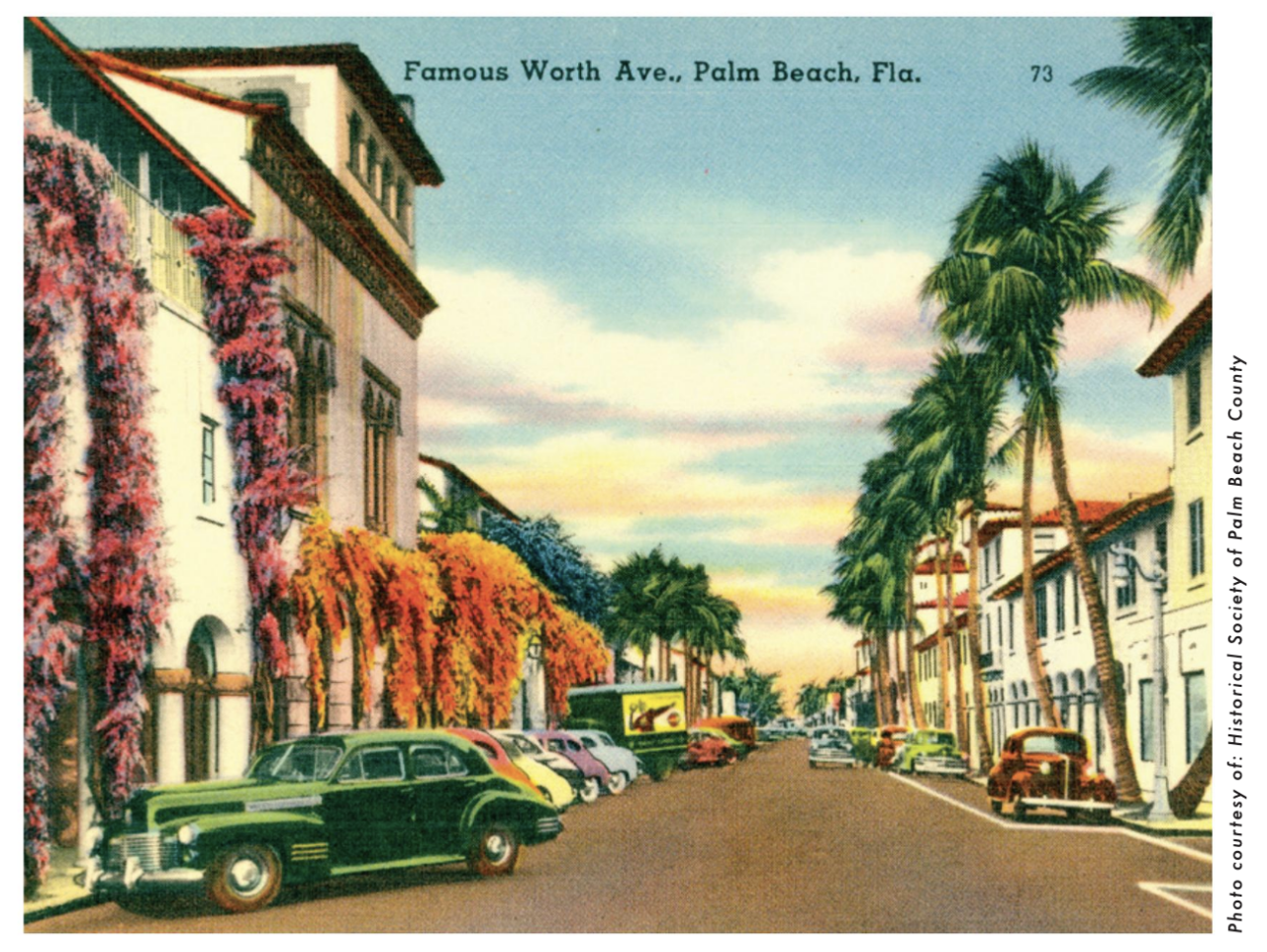A Look At Palm Beach Fashion History
During the Henry Flagler era from 1894 to 1913, the Gilded Age high society wintering in Palm Beach would have most likely brought most of their attire with them from up north. However, as reported by Florida Weekly, Brooks Brothers had a presence in Palm Beach beginning in 1909, when the company opened a store on South County Road to serve seasonal residents. At the time of its opening, it was Brooks Brothers’ third location, after New York City and Newport, Rhode Island. Otherwise, local retailers at that time located in downtown West Palm Beach were open year-round and therefore mainly catering to the local, non-seasonal market. The outbreak of World War I (1914 – 1918) changed everything. Although Palm Beach was already established as a Winter resort in the US market before the war, the most significant international Winter resort destinations prior to the war for affluent travelers were the French and Italian Rivieras. But with war raging in Europe, The Palm Beaches quickly became the favorite alternative as the new “American Riviera”, which eventually led to the Florida land boom of the 1920s.

Already in 1916, as reported by the Palm Beach Daily News, New York transplant retailer Stanley Warrick “witnessed an ever-growing influx of rich and impeccably dressed visitors to Palm Beach”. He enlisted a prominent architect to design the island’s first retail shopping complex called The Fashion Beaux Arts, which was located directly on the Lake Worth Lagoon between Everglades and Seminole Avenues. Lush tropical gardens surrounded the indoor/outdoor fashion mecca, which featured 20 high-fashion shops showcasing high-fashion clothing and accessories from renowned New York and Paris based fashion houses. Legendary cosmetics entrepreneur Helena Rubenstein opened a beauty salon at the new shopping destination, one of the earliest international brands to open in Palm Beach. Warrick proclaimed that Palm Beach Island had become “the winter fashion capital of the world”, beginning a new chapter in Palm Beach’s fascinating history in the realm of beauty and fashion.
In 1918, the arrival of 2 visionaries, Paris Singer and Addison Mizner, eventually helped lift Palm Beach retail to new heights. Singer, the 22nd son of inventor and industrialist Isaac Singer of Singer Sewing Machine Company fame, was displaced from his estate in Cap Ferrat, France, which had become a WWI refugee camp. Like many others, he instead came to Palm Beach. Singer, described as a “man of Luxury”, was purportedly dissatisfied with the social scene here and enlisted the help of his friend Addison Mizner to build the exclusive Everglades Club at the west end of Worth Avenue, which at that time was a gravel road with a few residences. The club, which opened in January of 1919, became the epicenter of social offerings on The Island with vibrant social programming including a litany of annual parties, galas, balls, tennis & golf tournaments and more. These activities increased the demand for all types of resort wear. To improve the offerings around the club for its members, Singer purchased adjacent property, eventually developing Via Mizner and Via Parigi where dozens of seasonal high-end boutiques offered fashion and accessories for the club’s social gatherings.

During the 1920s, Worth Avenue quickly became the most important high-end retail area. Kassatly’s, still a fixture on Worth Avenue today, opened in 1923. In 1924 Cartier opened their 2nd store in North America (after New York City) and in 1926 Saks Fifth Avenue opened their 2nd store on Worth Avenue, where the renowned department store still has a branch 97 years later. By the time popular architect Addison Mizner moved into his famous home in 1924, Villa Mizner on Worth Avenue, he was the most sought-after dinner-party guest on The Island. Mr. Mizner hosted almost daily cocktail soirees at Villa Mizner, hosting many of The Island’s most prominent winter residents, creative types and notable resort visitors, creating buzz on “The Avenue”. Those infamous gatherings personified the post-World War I rise of America’s elite “cocktailing classes” and were the start of a new Palm Beach tradition for both men and notably women to gather for drinks between 6 – 8 pm. Mr. Mizner’s cocktail hour allowed prominent socialites to show off their latest couture attire from famous designers on Worth Avenue.
By the 1930s, the importance of Palm Beach as a fashion mecca was well established. In coordination with merchants in the Worth Avenue Association, The Everglades Club began hosting “Tombolas”, which were weekly luncheon fashion shows with many of the world’s leading designers showing their “’couture” to high society. The New York Times regularly reported on the events, mentioning the most important “Who’s Who” of American industry in attendance. These luncheons went on for decades, helping establish many designers in the American luxury designer market such as Gucci, Bill Blass, Givenchy and Valentino.
Over the last century, numerous luxury retailers and designer brands have played an important role in establishing Palm Beach as a key luxury market for the fashion industry. In addition to those already mentioned above, other notable boutiques and brands that have played an important role in Palm Beach include Martha’s, Sara Fredricks, Maus & Hoffman, Bonwit Teller, Stubbs & Wootton, Givenchy, Halston, Oscar de la Renta, Pucci, Lacoste, Alfred Fiandaca, Arnold Stasi, Ralph Lauren, Chanel, Louis Vuitton, Hermes, Ferragamo, Brioni and Lilly Pulitzer.

This season the Richard and Pat Johnson Palm Beach County History Museum is presenting its first-ever Grand Exhibition called Endless Summer: Palm Beach Resort Wear, which will explore the impact Palm Beach made on resort fashion over the last 129 years. The highly anticipated exhibition runs from November 9, 2023 – May 25, 2024.
Written by TSG Palm Beach Contributing Editor, Rick Rose.




